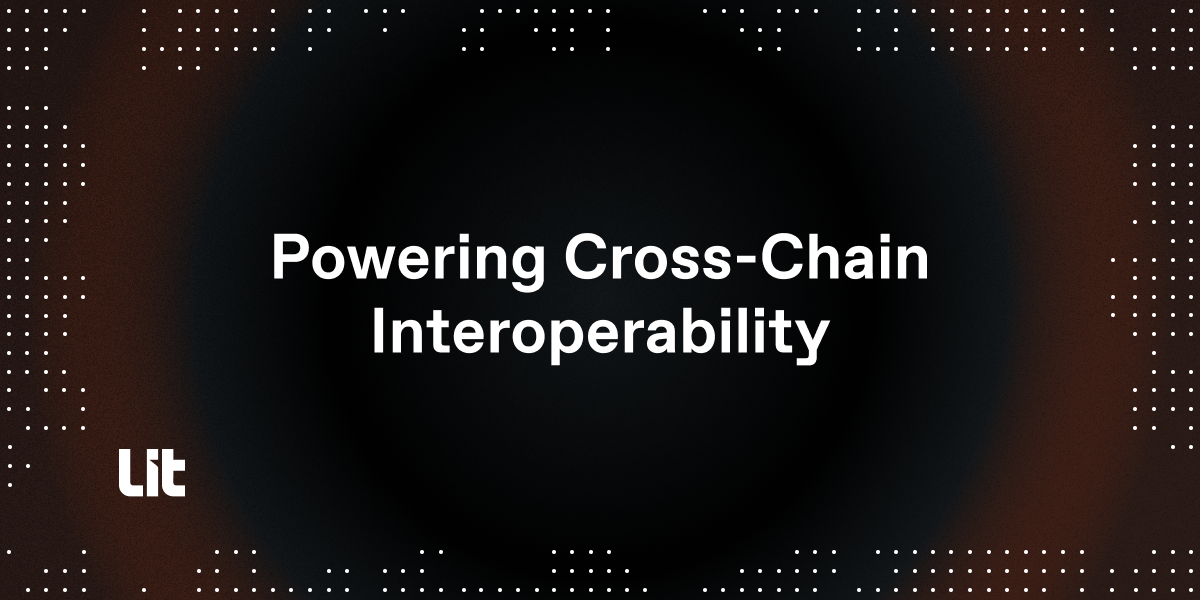Powering Cross-Chain Interoperability with Lit Protocol
Read about how Lit can be used to enable seamless cross-chain interoperability.

Overview
Cross-chain interoperability—enabling seamless communication and asset movement across any blockchain—largely remains an unsolved problem. Without a solution, the entire web3 ecosystem remains fragmented, hindering widespread adoption. Today, users face significant barriers: managing multiple wallets and accounts for different chains creates a disjointed experience, requiring technical expertise to navigate across disparate ecosystems like Ethereum, Solana, and Bitcoin. Bridging assets between chains is equally cumbersome, involving complex processes and multiple gas tokens, which inflate costs and deter non-crypto natives. Security risks loom large, with bridges losing billions of dollars in crypto assets to exploits due to vulnerabilities or custodial trust assumptions. Current solutions often trade security for convenience, relying on centralized intermediaries that contradict web3’s ethos of decentralization.
These frictions stifle adoption by alienating mainstream users who expect intuitive, unified experiences akin to web2 applications. Developers also struggle, forced to build chain-specific dApps that limit functionality and user reach. Solving cross-chain interoperability is critical to unlocking web3’s potential: it enables seamless asset transfers, unified user identities, and cross-chain dApp interactions, fostering a cohesive ecosystem where users can engage without worrying about underlying blockchain complexities. By bridging ecosystems, interoperability drives innovation, supports scalable DeFi and NFT markets, and aligns with the decentralized promise of user sovereignty. Lit Protocol addresses these challenges with secure, non-custodial, and programmable solutions, paving the way for an interconnected and user-owned web.
Lit’s Solution
Lit Protocol mitigates the pain points of cross-chain interoperability via decentralized key management, offering three key improvements to the status quo:
- Non-Custodial Security: Lit keys leverage multi-party computation threshold signature schemes (MPC TSS) to distribute key shares across a distributed set of nodes, ensuring no single entity ever holds the complete key. This eliminates centralized trust assumptions and single points of failure. Additionally, all operations take place inside of trusted execution environments (TEEs), ensuring the confidentiality of all key material and operations processed by the network.
- Chain-Agnostic Functionality: Lit keys support signing transactions on any blockchain, including Bitcoin, EVM chains, Solana, Cosmos, and more. A single key can orchestrate actions across any web3 ecosystem, eliminating the need to manage a multitude of accounts for every chain.
- Fully Programmable: Using Lit Actions, developers can program keys to sign transactions based on custom conditions using on-chain or off-chain data. For example, a smart contract event emitted on Ethereum can be used to trigger a transaction on Solana, automating cross-chain workflows.
These features allow developers to create secure, unified, and automated cross-chain applications, streamlining user experiences and enhancing interoperability.
Client Profiles
Several projects are leveraging Lit Protocol to enable seamless cross-chain interactions. Below are five examples showcasing Lit’s impact in this category:
- Emblem Vault: Emblem Vault facilitates cross-chain asset management by allowing users to vault and transfer assets across blockchains like Bitcoin and Ethereum. Using Lit keys, they enable secure, non-custodial transactions without relying on centralized custodians or bridges.
- Tria: Tria unifies liquidity and user experiences across EVM and non-EVM chains, enabling gasless, seedless cross-chain transactions. Lit keys are used to power their secure, chain-agnostic wallet and transaction signing, radically simplifying cross-chain interactions.
- Genius: Genius has built a DeFi super-app, enabling one-click token swaps across any chain. Genius eliminates the need to use bridges or manage multiple gas tokens, instead allowing users to transfer one asset for another while paying fees in any token of their choice. Genius uses Lit keys and Lit Actions to orchestrate liquidity and verify transactions.
- GVNR: GVNR enables seamless transaction execution across any blockchain network, specifically focused on bringing Bitcoin support to the rest of the DeFi ecosystem. GVNR has deployed custom smart contract vaults to their target destination chains which are controlled by Lit keys that serve as “orchestrator” accounts. Custom Lit Action logic dictates the rules that Lit keys use to move assets around these chains, coordinated by GVNR nodes participating in protocol consensus.
- Eco: Eco is designed to be the default protocol for apps that use stablecoins or need stablecoin liquidity. Eco’s cross-chain transaction system enables secure token transfer pathways between any other rollup settling on Ethereum (L2 or L3), with a network of fillers providing on-demand liquidity for user intents. Eco currently uses Lit to provision user accounts using familiar sign-on methods like email and passkeys, and is currently working on integrating Lit into the backend of the cross-chain transaction system to enable fully decentralized order matching and settlement between users (submitting intents) and fillers (executing intents).
Conclusion
Lit Protocol helps alleviate the frictions associated with cross-chain interoperability by addressing asset fragmentation, bridging vulnerabilities, and complexities associated with account management. Lit’s non-custodial, chain-agnostic, and programmable keys empower developers to build secure, seamless applications that have the power to unify previously disconnected web3 applications and protocols.
Builders looking to leverage this functionality can get started by following the Lit developer documentation: https://developer.litprotocol.com/
Stay up to date by following @LitProtocol on X or joining the Lit community on Telegram or Discord.
Use Lit to build the future of cross-chain interop today.
